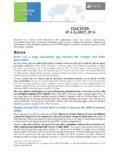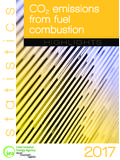Transcription of Education at a Glance: OECD Indicators
1 Education at a glance : OECD Indicators is the authoritative source for accurate and relevant information on the state of Education around the world. It provides data on the structure, finances and performance of the Education systems in the 34 OECD member countries, as well as a number of G20 and partner countries. Canada Canada has a highly educated population, due in large part to high attainment rates at the college level In 2012, 53% of Canadian adults held a tertiary qualification, the highest share among OECD countries (OECD average: 32%). The share of Canadians aged 25-64 with tertiary Education increased by 13 percentage points between 2000 and 2012.
2 Canada s tertiary attainment rate among 25-34 year-olds (57%) is surpassed by only Japan (59%) and Korea (66%) in the OECD. Canada s high ranking is largely due to its high rates of vocational (tertiary-type B) college-based attainment rather than academic university (tertiary-type A) Canada ranks first among 34 OECD countries in the proportion of 25-64 year-olds with a college Education (24%), but is tied for seventh place (with Korea and Denmark) in the proportion of adults with a university Education (28%). As in most OECD countries, women are more likely than men to hold a tertiary qualification. This gender gap is greater amongst 25-34 year-olds (66% for women versus 48% for men) than amongst the broader 25-64 year-old age grouping (58% for women versus 47% for men), reflecting faster attainment growth for women than for men.
3 Canadian adults rank near the OECD average on foundational skills development, while Canadian youth rank above average. Canadian adults rank at the OECD average in literacy scores and below average in numeracy scores. As in other OECD countries, higher Education in Canada is associated with higher levels of literacy and numeracy. In Canada, the Survey of Adult Skills2 found that the average difference in literacy score between adults with tertiary Education and those with below upper secondary Education is 71 points, similar to the difference found in Germany and the United States, but considerably higher than the OECD average of 62 points.
4 The mean literacy and numeracy scores of Canadian upper secondary and tertiary graduates falls below the OECD average for people with those levels of Education . Canadian 15-year-olds score significantly above the OECD average in mathematics, but between 2003 and 2012 their average mathematics scores deteriorated, while the share of top performers decreased and the share of low performers increased. Boys scored higher than girls 1 For the purposes of this note, the term college refers to both community colleges and polytechnics. It is important to note that many community colleges and polytechnics in Canada offer both tertiary-type 5B and non-tertiary post-secondary type 4 programmes, including occupational preparation and adult Education programmes.
5 Statistics Canada data on tertiary Education do not distinguish between some adult Education and occupational preparation programmes, so international comparisons of tertiary Education systems should be handled with some caution. 2 The Survey of Adult Skills is a product of the OECD Programme for the International Assessment of Adult Competencies (PIAAC). Canada Country Note Education at a glance 2014: OECD Indicators OECD in mathematics, with the difference between their scores being around the OECD average. The strength of the relationship between the performance and socio-economic status in Canada is weaker than the average for OECD countries, indicating that the Education system is producing relatively equitable outcomes for students.
6 As in other OECD countries, highly skilled workers are rewarded in the labour market. In 2012, 82% of adults (25-64 year-olds) with tertiary Education were employed compared with 75% of those with upper secondary or post-secondary non-tertiary Education and 56% of those with less than upper secondary Education . Among 25-34 year-olds, employment rates for these educational levels were 84%, 79% and 59% respectively. In Canada, as in other OECD countries, employment income increases with Education . In 2011, adults (25-64 year-olds) with university Education earned approximately 60% more on average than adults with upper secondary Education , while adults with college Education earned approximately 13% more.
7 Among 25-34 year-olds, people with university and college Education earned 33% and 10% more respectively than those with upper secondary Education . These earnings premiums are lower than the OECD average. Adults with less than upper secondary Education earned about 13% less on average than those with upper secondary Education . Spending on Education in Canada is close to the OECD average, with a relatively high share of private funding. In 2011, public spending on all levels of Education in Canada represented approximately 13% of total public expenditures and of GDP, both of which are close to the OECD average. Annual expenditure per tertiary student in Canada is one of the highest of all OECD and G20 countries, however.
8 The private share of funding at the tertiary level, at 43% in 2011, is well above the OECD average of 31%, but is considerably less than the share of private funding in the United States (65%) and the United Kingdom (70%). Canada ranks among the countries with the highest tuition fees. Other findings The proportion of 15-29 year-olds who were neither employed nor in Education or training (NEET) increased from 12% in 2008 to 13% in 2012. The OECD average has remained stable at 17% between 2008 and 2012. The participation rate in formal and/or non-formal Education among 25-64 year-olds was 58% in Canada in 2012, 7 percentage points higher than the OECD average.
9 As in most OECD countries, participation was higher for employed than unemployed people, and increased with the level of educational attainment. Canada s share of international students increased from in 2000 to in 2012. In the same period, the United States saw its share of international students decline from 23% to 16%. This work is published under the responsibility of the Secretary-General of the OECD. The opinions expressed and arguments employed herein do not necessarily reflect the official views of OECD member countries. This document and any map included herein are without prejudice to the status of or sovereignty over any territory, to the delimitation of international frontiers and boundaries and to the name of any territory, city or area.
10 For more information on Education at a glance 2014 and to access the full set of Indicators , visit Questions can be directed to: Corinne Heckmann Directorate for Education and Skills Email: Country Note author: Andrew Bell Directorate for Education and Skills Email: Key Facts for Canada in Education at a glance 2014 TableIndicator Rank among OECD countries and partner countries*Enrolment rates20112005201220053-year-olds (in early childhood Education )mm70%64%4-year-olds (in early childhood and primary Education )mm84%79% year-olds (all levels)99%98%16 of 44 Percentage of population that has only attained below upper secondary year-olds11%19%24%34%29 of 36 Percentage of the population whose highest level of attainment is upper secondary year-olds36%41%44%44%27 of 37 Percentage of population that has attained tertiary education201220002012200025-64 year-olds53%40%33%22%2 of 3725-34 year-olds57%48%40%26% 3 of 3655-64 year-olds44%28%25%15% 3 of 36 Entry rates into tertiary education2012200020122000 Youth expected to enter tertiary-type A programmes before turning 25mm48%mGraduation of today s young people expected to complete upper secondary Education in their lifetime88%m84%76% of today s young people expected to complete university Education











